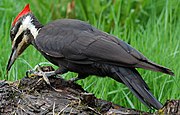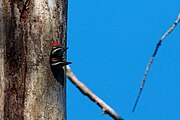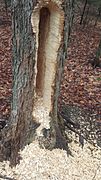
The European green woodpecker is a large green woodpecker with a bright red crown and a black moustache. Males have a red centre to the moustache stripe which is absent in females. It is resident across much of Europe and the western Palearctic but in Spain and Portugal it is replaced by the similar Iberian green woodpecker.

Woodpeckers are part of the bird family Picidae, which also includes the piculets, wrynecks and sapsuckers. Members of this family are found worldwide, except for Australia, New Guinea, New Zealand, Madagascar and the extreme polar regions. Most species live in forests or woodland habitats, although a few species are known that live in treeless areas, such as rocky hillsides and deserts, and the Gila woodpecker specialises in exploiting cacti.

The common goldeneye or simply goldeneye is a medium-sized sea duck of the genus Bucephala, the goldeneyes. Its closest relative is the similar Barrow's goldeneye. The genus name is derived from the Ancient Greek boukephalos, a reference to the bulbous head shape of the bufflehead. The species name is derived from the Latin clangere.

The black woodpecker is a large woodpecker that lives in mature forests across the northern Palearctic. It is the sole representative of its genus in that region. Its range is expanding. The black woodpecker is easily the largest woodpecker species in Europe as well as in the portion of Asia where it lives and is one of the largest species worldwide. This non-migratory species tends to make its home in old-growth forest or large forest stands and excavates a large tree hole to reside in. In turn, several species rely on black woodpeckers to secondarily reside in the holes made in trees by them. This woodpeckers diet consists mostly of carpenter ants. This species is closely related to, and fills the same ecological niche in Europe as, the pileated woodpecker of North America and the lineated woodpecker of South America, also being similar to the white-bellied woodpecker which is distributed to the south somewhat of the black woodpecker in Asia.

The northern flicker or common flicker is a medium-sized bird of the woodpecker family. It is native to most of North America, parts of Central America, Cuba, and the Cayman Islands, and is one of the few woodpecker species that migrate. Over 100 common names for the northern flicker are known, including yellowhammer, clape, gaffer woodpecker, harry-wicket, heigh-ho, wake-up, walk-up, wick-up, yarrup, and gawker bird. Many of these names derive from attempts to imitate some of its calls. It is the state bird of Alabama.

The red-headed woodpecker is a mid-sized woodpecker found in temperate North America. Its breeding habitat is open country across southern Canada and the east-central United States. It is rated as least concern on the International Union for Conservation of Nature (IUCN)'s Red List of Endangered species, having been down-listed from near threatened in 2018.
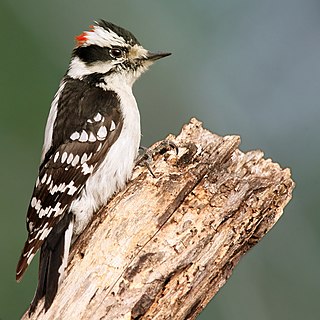
The downy woodpecker is a species of woodpecker, the smallest in North America. Length ranges from 14 to 18 cm. Downy woodpeckers primarily live in forested areas throughout the United States and Canada, with the exception of deserts in the southwest and the northern tundra. The bird nests in tree cavities and feeds primarily on insects, although it supplements its diet with seeds and berries. The downy woodpecker is very similar in appearance to the hairy woodpecker, although they are not closely related.

The acorn woodpecker is a medium-sized woodpecker with a length of around 20 cm (8 in), and an average weight of 85 g (3.0 oz). It is found across Central America, as well as the western United States and parts of Colombia.

The red-bellied woodpecker is a medium-sized woodpecker of the family Picidae. It breeds mainly in the eastern United States, ranging as far south as Florida and as far north as Canada. Though it has a vivid orange-red crown and nape it is not to be confused with the red-headed woodpecker, a separate species of woodpecker in the same genus with an entirely red head and neck that sports a solid black back and white belly. The red-bellied earns its name from the pale reddish blush of its lower underside.

The eastern screech owl or eastern screech-owl, is a small owl that is relatively common in Eastern North America, from Mexico to Canada. This species resides in most types of woodland habitats across its range, and is relatively adaptable to urban and developed areas compared to other owls. Although it often lives in close proximity to humans, the eastern screech owl frequently avoids detection due to its strictly nocturnal habits.

The red-cockaded woodpecker is a woodpecker endemic to the southeastern United States.

The flammulated owl is a small migratory North American owl in the family Strigidae. It is the only species placed in the genus Psiloscops.

The lineated woodpecker is a very large woodpecker which is a resident breeding bird from southern Mexico to northern Argentina and Trinidad in the Caribbean.

The white-bellied woodpecker or great black woodpecker is a woodpecker species inhabiting evergreen forests in tropical Indian subcontinent and Southeast Asia. It is among the largest of the Asiatic woodpeckers and nests in large dead trees, often beside rivers. It has 14 subspecies, and many of its island forms are endangered, some are extinct. Populations differ in the distribution and extent of white. Its drums and calls are louder than those of the smaller woodpeckers.

Dryocopus is a genus of large powerful woodpeckers, typically 35–45 cm in length. It has representatives in North and South America, Europe, and Asia; some South American species are endangered. It was believed to be closely related to the American genus Campephilus, but it is part of a different lineage of woodpeckers altogether
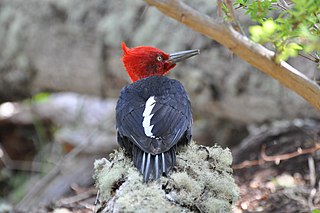
The Magellanic woodpecker is a species of large woodpecker found in southern Chile and southwestern Argentina; it is resident within its range. This species is the southernmost example of the genus Campephilus, which includes the famous ivory-billed woodpecker.

The helmeted woodpecker is a Vulnerable species of bird in subfamily Picinae of the woodpecker family Picidae. It is found in Argentina, Brazil, and Paraguay.

The Andaman woodpecker is a species of bird in the woodpecker family Picidae. It is endemic to the Andaman Islands in India. Its natural habitat is tropical moist lowland forests. It is threatened by habitat loss.
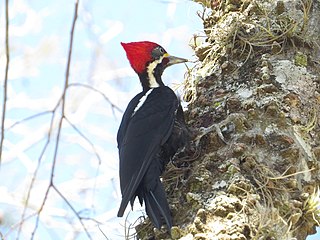
The black-bodied woodpecker is a Near Threatened species of bird in subfamily Picinae of the woodpecker family Picidae. It is found in Argentina, Bolivia, and Paraguay.
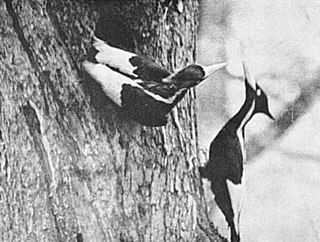
The ivory-billed woodpecker is a woodpecker that is native to the bottomland hardwood forests and temperate coniferous forests of the Southern United States and Cuba. Habitat destruction and hunting have reduced populations so thoroughly that the species is listed by the International Union for Conservation of Nature (IUCN) on its Red List as critically endangered, and by the American Birding Association as "definitely or probably extinct". The last universally accepted sighting of an American ivory-billed woodpecker occurred in Louisiana in 1944, and the last universally accepted sighting of a Cuban ivory-billed woodpecker occurred in 1987, after the bird's rediscovery there the prior year. Sporadic reports of sightings and other evidence of the persistence of the species have continued since then.









